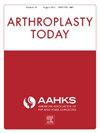A Contemporary Analysis of Discharge Disposition Following Total Joint Arthroplasty
IF 1.5
Q3 ORTHOPEDICS
引用次数: 0
Abstract
Background
Total joint arthroplasty (TJA) represents the single largest procedural cost for the Centers for Medicare & Medicaid Services. Discharge to a skilled nursing facility (SNF) remains a primary driver of post-acute care costs. The COVID-19 pandemic led to a decrease in number of discharges to SNFs. Examining preoperative patient characteristics of those who are still admitted to SNFs, despite cultural shifts, may help providers identify patients still at high risk for SNF discharge.
Methods
This retrospective study included patients who had elective total hip arthroplasty or total knee arthroplasty from January through December 2022 at a high-volume orthopaedic institute. Preoperative patient-reported outcome scores, demographics, and clinical characteristics were collected from patient charts and compared between patients who were discharged home vs SNF. Multivariate logistic regression analyses were used to determine potential predictors for discharge to SNF.
Results
In the total sample (N = 2795), 96.4% of patients were discharged home, and 3.6% were discharged to a SNF. Medicare insurance was associated with being discharged to a SNF (P < .05), while having commercial insurance was associated with being discharged home (P < .05). Being older, having longer procedure length, longer hospital length of stay, and a lower preoperative Patient-Reported Outcomes Measurement Information System (PROMIS 10) score were significant predictors of discharge to SNF (P < .05).
Conclusions
This was the first study to identify PROMIS 10 score as a potential predictor of discharge to a SNF after TJA. Findings from this study may help providers redefine contemporary predictors of SNF admission following TJA.
全关节置换术后出院处置的当代分析。
背景:全关节关节置换术(TJA)是美国医疗保险与医疗补助服务中心(Centers for Medicare & Medicaid Services)最大的一项手术费用。出院到专业护理机构(SNF)仍然是急性期后护理费用的主要驱动因素。COVID-19 大流行导致出院到专业护理机构的人数减少。尽管文化发生了转变,但研究那些仍被送往专业护理机构的患者的术前特征,可能有助于医疗服务提供者识别仍处于专业护理机构出院高风险的患者:这项回顾性研究纳入了 2022 年 1 月至 12 月期间在一家大医院骨科接受择期全髋关节置换术或全膝关节置换术的患者。研究人员从患者病历中收集了术前患者报告的结果评分、人口统计学特征和临床特征,并对出院回家与SNF患者进行了比较。多变量逻辑回归分析用于确定出院到SNF的潜在预测因素:在全部样本(N = 2795)中,96.4%的患者出院回家,3.6%的患者出院到SNF。医疗保险与出院后入住SNF有关(P < .05),而商业保险与出院后回家有关(P < .05)。年龄越大、手术时间越长、住院时间越长以及术前患者报告结果测量信息系统(PROMIS 10)评分越低,都是出院后转入SNF的重要预测因素(P < .05):这是第一项将 PROMIS 10 评分确定为 TJA 术后出院转入 SNF 的潜在预测因素的研究。这项研究的结果可能有助于医疗服务提供者重新定义 TJA 术后入住 SNF 的当代预测因素。
本文章由计算机程序翻译,如有差异,请以英文原文为准。
求助全文
约1分钟内获得全文
求助全文
来源期刊

Arthroplasty Today
Medicine-Surgery
CiteScore
2.90
自引率
0.00%
发文量
258
审稿时长
40 weeks
期刊介绍:
Arthroplasty Today is a companion journal to the Journal of Arthroplasty. The journal Arthroplasty Today brings together the clinical and scientific foundations for joint replacement of the hip and knee in an open-access, online format. Arthroplasty Today solicits manuscripts of the highest quality from all areas of scientific endeavor that relate to joint replacement or the treatment of its complications, including those dealing with patient outcomes, economic and policy issues, prosthetic design, biomechanics, biomaterials, and biologic response to arthroplasty. The journal focuses on case reports. It is the purpose of Arthroplasty Today to present material to practicing orthopaedic surgeons that will keep them abreast of developments in the field, prove useful in the care of patients, and aid in understanding the scientific foundation of this subspecialty area of joint replacement. The international members of the Editorial Board provide a worldwide perspective for the journal''s area of interest. Their participation ensures that each issue of Arthroplasty Today provides the reader with timely, peer-reviewed articles of the highest quality.
 求助内容:
求助内容: 应助结果提醒方式:
应助结果提醒方式:


